WebNN, Web 端侧推理的未来
胡宁馨 ningxin.hu@intel.com
张敏 belem.zhang@intel.com
张敏 belem.zhang@intel.com
英特尔 SATG Web 平台工程
2023 年 11 月
2023 年 11 月

WebML 客户端推理的优势
隐私
摄像头、麦克风等传感器数据保留在设备中
离线
初始资源缓存并离线后,不再依赖网络
延迟
无云端网络问题,浏览器实时推理
成本
无需云端算力支持
0 安装
浏览器中运行,无需额外安装,并易于共享
跨平台
在几乎所有平台上运行 AI 应用
WebML 客户端推理
突发的
延迟敏感
延迟敏感
持续的
电量敏感
电量敏感
周期的
吞吐量敏感
吞吐量敏感
多样的客户端 AI 场景, 多种满足需求的计算单元
CPU
无处不在
低延迟, 单一推理任务
无处不在
低延迟, 单一推理任务
GPU
高并行性, 高 batch size
与 3D/渲染/媒体管道集成
高并行性, 高 batch size
与 3D/渲染/媒体管道集成
NPU
专用低功耗AI加速器
高能耗比, 提升电源效率
专用低功耗AI加速器
高能耗比, 提升电源效率
Web 开发者的需求
The web needs its own neural networks specification to leverage Apple
Silicon, Tensor Cores, and
others.
Delighted to find the working drafts of WebNN. Incredible new power unlocked for the free, open and
competitive Web!
Native Tensor support! Would be amazing to have Tensor
objects and ops built into Chrome,
and available as an “ML API”.
Although some scientific computing libraries exist for JS/TS, having built-in
support would be far
more desirable!
If go through the code of utils, maths, audio, tensor in JS, it is annoying that I had to implement
these ops myself in JS.
llama2-7b in the browser – using WebNN – is going to be 🔥🔥
on-device, local ML 💪 cc @xenovacom
WebNN 简介
新兴的 W3C Web 标准 API
神经网络的统一抽象
通过原生 ML API 访问 AI 硬件加速器
接近原生的 AI 推理性能和结果的可靠性
目前在 Chrome 和 Edge Canary 中可用 (runtime flag)
WebNN 标准规范

- WebNN 标准规范由 W3C Web Machine Learning 工作组负责起草
- WebNN 标准规范由 Intel 及 Microsoft 联合编辑
WebNN 标准规范进展
已交付
- 2023 年 3 月: W3C CR
- 60 个 CNN/RNN 运算, float16/32, int32/uint32, int8/uint8
- 图像分类: SqueezeNet, MobileNet, ResNet
- 物体检测: TinyYOLO
- 噪声抑制: RNNoise, NSNet
进行中
- 2023 年末: W3C 候选推荐更新
- 18~22 个 Transformer ops, int64/uint64, NPU 和量化 (TBD)
目标模型
- Text-to-image: Stable Diffusion unet/VAE/text encoder
- Image segmentation: Segment Everything decoder
- Speech-to-text: Whisper Tiny
- Text-to-text 生成 (encoder-decoder): T5 及 M2M100
- Text-generation (decoder): LLaMA
WebNN 架构
WebNN 在 Chromium 中的实现
Neural Network Hardware Abstraction Layer / Microsoft Compute Driver Model / Windows
Display Driver Model
WebNN 操作符的实现状态 (部分)
|
WebNN Spec |
Web Platform Tests |
XNNPack/CPU backend | External Delegate | Execution Provider |
|---|---|---|---|---|
 
|
Lite for TensorFlow.js | |||
|
|
||||
|
clamp
|
📈
🧪
|
✅ clamp |
✅ ReluN1To1
|
✅ Clip
|
| ✅ Relu6 | ||||
|
concat |
📈
🧪
|
✅ concatenate2 |
✅ Concatenation |
✅ Concat |
| ✅ concatenate3 | ||||
| ✅ concatenate4 | ||||
|
conv2d
|
📈
🧪
|
✅ convolution_2d
|
✅ Conv2d |
✅ Conv
|
| ✅ DepthwiseConv2d | ||||
|
convTranspose2d
|
📈
🧪
|
✅ deconvolution_2d
|
✅ TransposeConv |
✅ ConvTranspose
|
| ✅ Convolution2DTransposeBias | ||||
| add element-wise binary | 📈 🧪 | ✅ add2 | ✅ Add | ✅ Add |
| sub element-wise binary | 📈 🧪 | ✅ subtract | ✅ Sub | ✅ Sub |
| mul element-wise binary | 📈 🧪 | ✅ multiply2 | ✅ Mul | ✅ Mul |
| div element-wise binary | 📈 🧪 | ✅ divide | ✅ Div | ✅ Div |
| max element-wise binary | 📈 🧪 | ✅ maximum2 | ✅ Maximum | ✅ Max |
| min element-wise binary | 📈 🧪 | ✅ minimum2 | ✅ Minimum | ✅ Min |
| abs element-wise unary | 📈 🧪 | ✅ abs | ✅ Abs | ✅ Abs |
| ceil element-wise unary | 📈 🧪 | ✅ ceiling | ✅ Ceil | ✅ Ceil |
| floor element-wise unary | 📈 🧪 | ✅ floor | ✅ Floor | ✅ Floor |
| neg element-wise unary | 📈 🧪 | ✅ negate | ✅ Neg | ✅ Neg |
| elu | 📈 🧪 | ✅ elu | ✅ Elu | ✅ Elu |
| gemm | 📈 🧪 | ✅ fully_connected | ✅ FullyConnected | ✅ Gemm |
WebNN 操作符的实现状态 (部分)
|
WebNN Spec |
Web Platform Tests |
XNNPack/CPU backend | External Delegate | Execution Provider |
|---|---|---|---|---|
 
|
Lite for TensorFlow.js
|
|||
|
|
||||
| hardSwish | 📈 🧪 | ✅ hardswish | ✅ HardSwish | ✅ HardSwish |
| leakyRelu | 📈 🧪 | ✅ leaky_relu | ✅ LeakyRelu | ✅ LeakyRelu |
| pad | 📈 🧪 | ✅ static_constant_pad | ✅ Pad | ✅ Pad |
|
averagePool2d
pooling
|
📈
🧪
|
✅ average_pooling_2d
|
✅ AveragePool2d | ✅ GlobalAveragePool |
| ✅ Mean | ✅ AveragePool | |||
|
maxPool2d
pooling
|
📈
🧪
|
✅ max_pooling_2d
|
✅ MaxPool2d
|
✅ GlobalMaxPool |
| ✅ MaxPool | ||||
| prelu | 📈 🧪 | ✅ prelu | ✅ Prelu | ✅ Prelu |
| relu | 📈 🧪 | ✅ clamp | ✅ Relu | ✅ Relu |
| resample2d | 🚀🚀 | ✅ static_resize_bilinear_2d | ✅ ResizeBilinear | ✅ Resize |
| reshape | 📈 🧪 | ✅ static_reshape | ✅ Reshape | ✅ Reshape |
| sigmoid | 📈 🧪 | ✅ sigmoid | ✅ Logistic | ✅ Sigmoid |
|
split |
📈
🧪
|
✅ even_split2 |
✅ Split |
✅ Split |
| ✅ even_split3 | ||||
| ✅ even_split4 | ||||
| ✅ static_slice (uneven split) | ||||
| slice | 📈 🧪 | ✅ static_slice | ✅ Slice | ✅ Slice |
| ✅ StridedSlice | ||||
| softmax | 📈 🧪 | ✅ softmax | ✅ Softmax | ✅ Softmax |
| transpose | 📈 🧪 | ✅ static_transpose | ✅ Transpose | ✅ Transpose |
| 78 | 29 | 35 | 34 | 68 |
WebNN 的实现状态 (DirectML)
- 目前已经支持 40 个 ops
- Transfomer 的 ops 也正与 spec 同步开发中
- 正在为 WebNN NPU 支持作出适配
WebNN 编程模型
WebNN 代码示例
const context = await navigator.ml.createContext({powerPreference: 'low-power'});
// The following code builds a graph as:
// constant1 ---+
// +--- Add ---> intermediateOutput1 ---+
// input1 ---+ |
// +--- Mul---> output
// constant2 ---+ |
// +--- Add ---> intermediateOutput2 ---+
// input2 ---+
// Use tensors in 4 dimensions.
const TENSOR_DIMS = [1, 2, 2, 2];
const TENSOR_SIZE = 8;
const builder = new MLGraphBuilder(context);
// Create MLOperandDescriptor object.
const desc = {dataType: 'float32', dimensions: TENSOR_DIMS};
// constant1 is a constant MLOperand with the value 0.5.
const constantBuffer1 = new Float32Array(TENSOR_SIZE).fill(0.5);
const constant1 = builder.constant(desc, constantBuffer1);
// input1 is one of the input MLOperands. Its value will be set before execution.
const input1 = builder.input('input1', desc);
// constant2 is another constant MLOperand with the value 0.5.
const constantBuffer2 = new Float32Array(TENSOR_SIZE).fill(0.5);
const constant2 = builder.constant(desc, constantBuffer2);
// input2 is another input MLOperand. Its value will be set before execution.
const input2 = builder.input('input2', desc);
// intermediateOutput1 is the output of the first Add operation.
const intermediateOutput1 = builder.add(constant1, input1);
// intermediateOutput2 is the output of the second Add operation.
const intermediateOutput2 = builder.add(constant2, input2);
// output is the output MLOperand of the Mul operation.
const output = builder.mul(intermediateOutput1, intermediateOutput2);
// Compile the constructed graph.
const graph = await builder.build({'output': output});
// Setup the input buffers with value 1.
const inputBuffer1 = new Float32Array(TENSOR_SIZE).fill(1);
const inputBuffer2 = new Float32Array(TENSOR_SIZE).fill(1);
const outputBuffer = new Float32Array(TENSOR_SIZE);
// Execute the compiled graph with the specified inputs.
const inputs = {
'input1': inputBuffer1,
'input2': inputBuffer2,
};
const outputs = {'output': outputBuffer};
const results = await context.compute(graph, inputs, outputs);
console.log('Output value: ' + results.outputs.output);
// Output value: 2.25,2.25,2.25,2.25,2.25,2.25,2.25,2.25
WebNN 和主流 JavaScript ML 框架的集成
WebNN 与 ONNXRuntime Web 集成的代码示例
import { InferenceSession } from "onnxruntime-web";
// ...
// Initialize the ONNX model
const initModel = async () => {
ort.env.wasm.numThreads = 1; // 4
ort.env.wasm.simd = true;
ort.env.wasm.proxy = true;
const options: InferenceSession.SessionOptions = {
// provider name: wasm, webnn
// deviceType: cpu, gpu
// powerPreference: default, high-performance
executionProviders:
[{ name: "wasm"}], // WebAssembly CPU
};
// ...
};
const results = await model.run(feeds);
const output = results[model.outputNames[0]];
WebAssembly 后端
import { InferenceSession } from "onnxruntime-web";
// ...
// Initialize the ONNX model
const initModel = async () => {
env.wasm.numThreads = 1; // 4
env.wasm.simd = true;
env.wasm.proxy = true;
const options: InferenceSession.SessionOptions = {
// provider name: wasm, webnn
// deviceType: cpu, gpu
// powerPreference: default, high-performance
executionProviders:
[{ name: "webnn", deviceType: "gpu", powerPreference: 'default' }],
};
// ...
};
const results = await model.run(feeds);
const output = results[model.outputNames[0]];
WebNN 后端
WebNN XNNPack/CPU 性能数据 (标准化)
MediaPipe 模型, 越高越好
W3C Machine Learning for the Web
社区组
讨论和探索新想法,孵化机器学习推理的新提案
39 个组织代表, 126 名参与者
39 个组织代表, 126 名参与者
工作组
基于社区组孵化的提案,标准化机器学习推理的 Web API
17 个组织代表, 43 名参与者 (3 名特邀专家)
17 个组织代表, 43 名参与者 (3 名特邀专家)
Local Peer-to-Peer API
- 通过近距离通信传输数据、消息或文件
- 隐藏各底层点对点技术的复杂性
- 于 2023 年 11 月 10 日进入 W3C Web Incubator CG 孵化
- 基于 Open Screen, QUICHE 等实现
谢谢!
 https://webnn.dev
https://webnn.dev
 WebNN 交流群
WebNN 交流群
 张敏 (Belem)
张敏 (Belem)